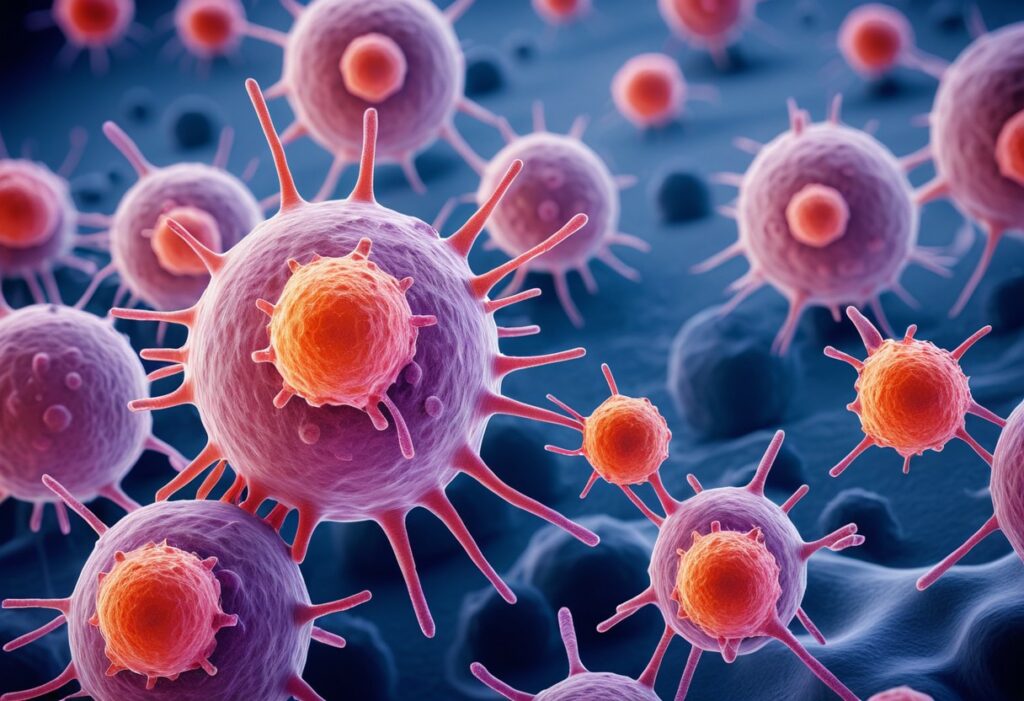Cancer, a multifaceted and heterogeneous group of diseases, remains one of the leading causes of morbidity and mortality worldwide. Understanding the causes and risk factors associated with cancer is crucial for prevention, early detection, and effective management. This article delves into the intricate web of factors contributing to cancer development, shedding light on both modifiable and non-modifiable risk factors.
Genetic Predisposition:
Cancer is a complex disease characterized by genetic alterations that disrupt normal cellular processes and drive uncontrolled cell growth. While environmental factors play a significant role in cancer development, genetic predisposition also contributes to an individual’s susceptibility to certain types of cancer. Inherited mutations in specific genes can significantly increase the risk of developing cancer, highlighting the importance of genetic testing and counseling in cancer prevention and early detection. This article explores the role of genetic predisposition in cancer susceptibility, focusing on hereditary cancer syndromes and the impact of genetic testing on personalized cancer care.
Hereditary Cancer Syndromes:
Hereditary cancer syndromes are inherited conditions caused by mutations in specific genes that significantly increase the risk of developing certain types of cancer. These mutations can be passed down from one generation to the next and are associated with a familial pattern of cancer occurrence. Examples of hereditary cancer syndromes include:
- BRCA1 and BRCA2 Mutations: Mutations in the BRCA1 and BRCA2 genes are associated with an increased risk of breast, ovarian, prostate, and pancreatic cancers. Women with BRCA1 or BRCA2 mutations have a significantly higher lifetime risk of developing breast and ovarian cancer compared to the general population.
-
Lynch Syndrome: Lynch syndrome, also known as hereditary nonpolyposis colorectal cancer (HNPCC), is caused by mutations in genes responsible for DNA mismatch repair, such as MLH1, MSH2, MSH6, and PMS2. Individuals with Lynch syndrome have an elevated risk of developing colorectal cancer, as well as other cancers including endometrial, ovarian, gastric, and urinary tract cancers.
-
Familial Adenomatous Polyposis (FAP): FAP is characterized by the development of numerous precancerous polyps in the colon and rectum, which, if left untreated, can progress to colorectal cancer. FAP is caused by mutations in the APC gene, and individuals with this condition have a nearly 100% lifetime risk of developing colorectal cancer without intervention.
-
Li-Fraumeni Syndrome: Li-Fraumeni syndrome is a rare inherited condition caused by mutations in the TP53 gene, which encodes a tumor suppressor protein. Individuals with Li-Fraumeni syndrome have an increased risk of developing a wide range of cancers, including breast cancer, sarcoma, brain tumors, and leukemia, at an early age.
Genetic Testing and Counseling:
Genetic testing plays a crucial role in identifying individuals at increased risk of hereditary cancer syndromes and informing personalized screening and preventive strategies. Genetic testing can identify specific mutations associated with hereditary cancer syndromes, allowing individuals to make informed decisions about their healthcare and take proactive steps to reduce their cancer risk. Genetic counseling, provided by trained professionals, helps individuals understand the implications of genetic testing results, navigate complex medical decisions, and cope with the psychological and emotional aspects of genetic testing.
The Impact of Genetic Predisposition on Personalized Cancer Care:
Genetic predisposition to cancer has significant implications for personalized cancer care, including screening, prevention, treatment, and surveillance strategies. Individuals with a known genetic predisposition to cancer may require more frequent screening exams, starting at an earlier age, to detect cancer at its earliest and most treatable stages. Additionally, preventive measures such as prophylactic surgery, chemoprevention, and lifestyle modifications may be recommended to reduce cancer risk in high-risk individuals. In the realm of cancer treatment, genetic testing can inform targeted therapies and precision medicine approaches, allowing for more effective and tailored treatment strategies based on the underlying genetic drivers of the cancer.
Genetic predisposition plays a significant role in cancer susceptibility, with inherited mutations contributing to a small but notable percentage of cases. Hereditary cancer syndromes, such as BRCA1 and BRCA2 mutations, Lynch syndrome, FAP, and Li-Fraumeni syndrome, highlight the impact of genetic factors on cancer risk. Genetic testing and counseling are essential tools for identifying individuals at increased risk of hereditary cancer syndromes and informing personalized screening and preventive strategies. By understanding the role of genetic predisposition in cancer development, healthcare providers and individuals can work together to implement proactive measures that reduce cancer risk and improve outcomes.
Environmental Exposures:
The global burden of cancer continues to rise, with environmental exposures emerging as significant contributors to cancer development. From tobacco smoke to industrial pollutants, a myriad of environmental carcinogens pose a threat to human health and increase the risk of various types of cancer. This section delves into the intricate relationship between environmental exposures and cancer risk, exploring the diverse array of carcinogens found in our surroundings and the measures individuals and policymakers can take to mitigate their impact.
Tobacco Smoke:
Tobacco smoke is one of the most well-established environmental carcinogens, responsible for a substantial proportion of cancer-related deaths worldwide. Cigarette smoke contains over 7,000 chemicals, including dozens of carcinogens such as polycyclic aromatic hydrocarbons (PAHs), nitrosamines, and benzene. Smoking is strongly associated with an increased risk of lung cancer, as well as cancers of the mouth, throat, esophagus, pancreas, bladder, and cervix. Secondhand smoke exposure also poses a significant risk, particularly for nonsmokers living with smokers or working in environments where smoking is allowed.
Air Pollutants:
Outdoor and indoor air pollutants are another significant environmental risk factor for cancer. Fine particulate matter (PM2.5), nitrogen dioxide (NO2), sulfur dioxide (SO2), ozone (O3), and volatile organic compounds (VOCs) emitted from vehicle exhaust, industrial emissions, power plants, and indoor sources such as cooking and heating appliances can contribute to cancer development. Long-term exposure to air pollution has been linked to an increased risk of lung cancer, as well as cardiovascular diseases and respiratory conditions. Efforts to reduce air pollution through clean energy initiatives, emissions regulations, and urban planning strategies are critical for protecting public health and reducing cancer risk.
Industrial Chemicals:
Occupational exposures to industrial chemicals pose significant risks for cancer development among workers in various industries. Carcinogenic substances such as asbestos, benzene, formaldehyde, arsenic, and vinyl chloride are commonly found in workplaces such as asbestos mining, construction, manufacturing, and chemical production. Prolonged exposure to these carcinogens can lead to the development of lung cancer, mesothelioma, leukemia, bladder cancer, and other malignancies. Occupational safety measures, including proper ventilation, personal protective equipment, and workplace monitoring programs, are essential for minimizing exposure and preventing occupational cancers.
Pesticides:
Pesticides are widely used in agriculture to protect crops from pests, but exposure to these chemicals can have detrimental effects on human health. Many pesticides contain carcinogenic compounds such as organochlorines, organophosphates, and glyphosate, which have been linked to an increased risk of various cancers, including non-Hodgkin lymphoma, leukemia, and prostate cancer. Agricultural workers, pesticide applicators, and individuals living in farming communities are at heightened risk of pesticide exposure. Integrated pest management strategies, organic farming practices, and pesticide use regulations are essential for reducing pesticide exposure and protecting public health.
Radiation:
Exposure to ionizing radiation, whether from natural or man-made sources, is a well-established risk factor for cancer. Ultraviolet (UV) radiation from sunlight is a major cause of skin cancer, including basal cell carcinoma, squamous cell carcinoma, and melanoma. Medical imaging procedures such as X-rays and CT scans, as well as occupational exposure to radiation in industries such as nuclear power generation and radiology, can also increase cancer risk. Minimizing unnecessary radiation exposure, practicing sun safety measures, and implementing radiation protection protocols in healthcare settings are crucial for reducing the risk of radiation-induced cancers.
Infectious Agents:
Certain infectious agents, including viruses, bacteria, and parasites, have been implicated in the development of cancer. Human papillomavirus (HPV) infection is a major risk factor for cervical cancer, as well as other genital cancers and oropharyngeal cancers. Hepatitis B and C viruses (HBV and HCV) are known to cause liver cancer, while Helicobacter pylori infection is associated with an increased risk of stomach cancer. Vaccination against HPV and HBV, as well as screening and treatment for HCV and H. pylori infection, are important strategies for preventing infection-related cancers.
Environmental exposures play a significant role in cancer risk, with a diverse array of carcinogens found in our surroundings contributing to cancer development. From tobacco smoke and air pollutants to industrial chemicals, pesticides, radiation, and infectious agents, a myriad of environmental factors can increase the risk of various types of cancer. Minimizing exposure to known carcinogens through workplace safety measures, environmental regulations, lifestyle modifications, and public health interventions is essential for cancer prevention. By raising awareness about the impact of environmental exposures on cancer risk and advocating for policies that promote a cleaner and safer environment, we can work towards reducing the global burden of cancer and protecting public health.
Lifestyle Factors:
Cancer is a multifaceted disease influenced by a myriad of factors, including genetic predisposition, environmental exposures, and lifestyle choices. While genetic and environmental factors play significant roles in cancer development, lifestyle choices can also exert a profound influence on cancer risk. In this section, we delve into the intricate relationship between lifestyle factors and cancer risk, exploring the impact of tobacco use, dietary habits, physical activity, alcohol consumption, obesity, and sun exposure on cancer development.
Tobacco Use:
Tobacco use stands as the single largest preventable cause of cancer, contributing to a significant proportion of cancer-related deaths worldwide. Cigarette smoking, in particular, is strongly linked to an increased risk of lung cancer, as well as cancers of the mouth, throat, esophagus, pancreas, bladder, cervix, and kidney. The harmful effects of tobacco are not limited to smokers; secondhand smoke exposure also poses a substantial risk, particularly for nonsmokers living with smokers or working in environments where smoking is allowed. Quitting smoking and avoiding exposure to secondhand smoke are essential steps individuals can take to reduce their risk of tobacco-related cancers.
Unhealthy Dietary Habits:
Diet plays a critical role in cancer prevention, with certain dietary patterns associated with an increased risk of cancer. Diets high in processed foods, red and processed meats, and saturated fats have been linked to a higher incidence of colorectal cancer, prostate cancer, and pancreatic cancer. Conversely, diets rich in fruits, vegetables, whole grains, and lean proteins are associated with a lower risk of cancer. Consumption of a plant-based diet, high in fiber, vitamins, minerals, and phytochemicals, can help reduce cancer risk and promote overall health. Limiting intake of sugary beverages, processed meats, and foods high in salt and trans fats is also recommended for cancer prevention.
Physical Activity:
Regular physical activity is associated with a reduced risk of several types of cancer, including breast, colon, endometrial, and prostate cancers. Exercise helps maintain a healthy weight, improves immune function, and reduces inflammation, all of which contribute to lower cancer risk. The American Cancer Society recommends at least 150 minutes of moderate-intensity or 75 minutes of vigorous-intensity physical activity per week for adults to reduce cancer risk. Incorporating activities such as walking, cycling, swimming, and strength training into daily routines can have significant health benefits and lower the risk of cancer and other chronic diseases.
Excessive Alcohol Consumption:
Excessive alcohol consumption is a well-established risk factor for cancer, with heavy drinking linked to an increased risk of cancers of the mouth, throat, esophagus, liver, breast, and colon. Alcohol is classified as a carcinogen by the International Agency for Research on Cancer (IARC), and the risk of cancer increases with higher levels of alcohol consumption. To reduce cancer risk, individuals are advised to limit alcohol intake to moderate levels, defined as up to one drink per day for women and up to two drinks per day for men. Abstaining from alcohol altogether is the safest option for cancer prevention, particularly for individuals at higher risk of alcohol-related cancers.
Obesity:
Obesity is a significant risk factor for cancer, with excess body weight linked to an increased risk of several cancers, including breast, colon, endometrial, kidney, pancreatic, and esophageal cancers. Adipose tissue produces hormones and cytokines that promote inflammation and cell proliferation, contributing to tumor growth and progression. Maintaining a healthy weight through a balanced diet and regular physical activity is essential for cancer prevention. Lifestyle modifications aimed at achieving and maintaining a healthy body weight can reduce cancer risk and improve overall health outcomes.
Sun Exposure:
Exposure to ultraviolet (UV) radiation from sunlight is a major risk factor for skin cancer, including basal cell carcinoma, squamous cell carcinoma, and melanoma. UV radiation damages the DNA in skin cells, leading to mutations that can result in cancerous growths. Sun exposure during peak hours (10 a.m. to 4 p.m.), unprotected exposure to sunlight, and indoor tanning bed use increase the risk of skin cancer. Sun safety measures, including wearing protective clothing, using sunscreen with a high SPF, seeking shade, and avoiding tanning beds, are essential for reducing the risk of skin cancer.
Lifestyle factors play a significant role in cancer risk, with tobacco use, unhealthy dietary habits, physical inactivity, excessive alcohol consumption, obesity, and sun exposure contributing to cancer development. By adopting healthy lifestyle choices, including quitting smoking, following a balanced diet, engaging in regular physical activity, limiting alcohol intake, maintaining a healthy weight, and practicing sun safety measures, individuals can reduce their risk of cancer and improve their overall health and well-being. Public health initiatives aimed at promoting healthy behaviors and creating supportive environments can further encourage individuals to make positive lifestyle changes that reduce cancer risk and enhance quality of life.
Chronic Inflammation and Immune Dysfunction:
Cancer, a leading cause of morbidity and mortality worldwide, arises from a complex interplay of genetic, environmental, lifestyle, and immunological factors. Among these, chronic inflammation and immune dysfunction have emerged as key contributors to cancer development, fostering a microenvironment conducive to tumor initiation, progression, and metastasis. In this comprehensive review, we delve into the intricate relationship between chronic inflammation, immune dysfunction, and cancer, exploring their underlying mechanisms and implications for cancer prevention and treatment.
Chronic Inflammation:
Chronic inflammation is a hallmark of cancer, characterized by sustained activation of inflammatory pathways and infiltration of immune cells into the tumor microenvironment. Conditions such as inflammatory bowel disease (IBD), chronic viral infections (e.g., hepatitis B and C viruses, human papillomavirus), autoimmune disorders (e.g., rheumatoid arthritis, systemic lupus erythematosus), and exposure to environmental pollutants and carcinogens can trigger chronic inflammation and increase cancer risk. Inflammation promotes tumorigenesis through multiple mechanisms, including DNA damage, oxidative stress, cytokine signaling, and immune evasion. Pro-inflammatory cytokines such as interleukin-6 (IL-6), tumor necrosis factor-alpha (TNF-alpha), and interleukin-1 beta (IL-1β) play critical roles in driving tumor growth, angiogenesis, and metastasis. Targeting inflammatory pathways and mediators holds promise for cancer prevention and treatment, with nonsteroidal anti-inflammatory drugs (NSAIDs), corticosteroids, and biologic agents showing potential as therapeutic interventions.
Immune Dysfunction:
Immune dysfunction, characterized by impaired immune surveillance and dysregulated immune responses, contributes to cancer development by failing to recognize and eliminate malignant cells. Immunodeficiency states, such as acquired immunodeficiency syndrome (AIDS), congenital immunodeficiencies, and immunosuppression following organ transplantation, increase susceptibility to certain cancers, particularly those caused by oncogenic viruses (e.g., Kaposi sarcoma, non-Hodgkin lymphoma, cervical cancer). Tumor cells employ various mechanisms to evade immune detection and destruction, including downregulation of major histocompatibility complex (MHC) molecules, expression of immune checkpoint proteins (e.g., programmed cell death protein 1 [PD-1], cytotoxic T-lymphocyte-associated protein 4 [CTLA-4]), and secretion of immunosuppressive factors (e.g., transforming growth factor-beta [TGF-beta], indoleamine 2,3-dioxygenase [IDO]). Immunotherapies, such as immune checkpoint inhibitors, adoptive cell therapy, and therapeutic vaccines, harness the power of the immune system to target and eliminate cancer cells, representing a paradigm shift in cancer treatment.
Interplay Between Chronic Inflammation and Immune Dysfunction:
Chronic inflammation and immune dysfunction are interconnected processes that fuel each other in a vicious cycle, perpetuating tumor-promoting inflammation and immune evasion. Inflammatory mediators released during chronic inflammation (e.g., cytokines, chemokines, prostaglandins) modulate immune cell function and recruitment, shaping the composition and activity of the tumor immune microenvironment. Conversely, immune cells, such as tumor-associated macrophages (TAMs), myeloid-derived suppressor cells (MDSCs), and regulatory T cells (Tregs), produce cytokines and growth factors that sustain chronic inflammation and support tumor progression. Understanding the crosstalk between chronic inflammation and immune dysfunction is crucial for developing targeted therapeutic strategies that disrupt tumor-promoting pathways and restore immune surveillance.
Implications for Cancer Prevention and Treatment:
Targeting chronic inflammation and immune dysfunction represents a promising approach for cancer prevention and treatment. Lifestyle modifications, such as adopting a healthy diet, maintaining a normal body weight, regular physical activity, and avoiding tobacco and alcohol use, can help reduce chronic inflammation and enhance immune function. Pharmacological interventions, including NSAIDs, corticosteroids, and biologic agents targeting inflammatory cytokines and immune checkpoint proteins, show potential for preventing inflammation-associated cancers and improving treatment outcomes. Immunotherapies, such as immune checkpoint inhibitors and chimeric antigen receptor (CAR) T-cell therapy, harness the immune system’s ability to recognize and eliminate cancer cells, offering new avenues for personalized cancer treatment.
Chronic inflammation and immune dysfunction are intricately linked processes that contribute to cancer development and progression. By elucidating the underlying mechanisms and interplay between these processes, researchers can identify novel therapeutic targets and develop innovative strategies for cancer prevention and treatment. Empowering individuals to adopt healthy lifestyle behaviors and promoting immunomodulatory interventions hold promise for reducing cancer risk and improving patient outcomes. Continued research efforts aimed at unraveling the complexities of chronic inflammation, immune dysfunction, and cancer will pave the way for more effective preventive and therapeutic interventions, ultimately advancing the fight against cancer and improving global public health.
Disclaimer:
The information provided in this article is for informational purposes only and is not intended as medical advice. It is not a substitute for professional medical diagnosis, treatment, or advice. Always seek the advice of your physician or other qualified healthcare provider with any questions you may have regarding a medical condition or treatment plan.










More Stories
Inside the Hormonal Symphony: Understanding the Endocrine System
Understanding Gallstones: Causes, Symptoms, and Treatment Options
The Intricacies of Cells: Exploring the Building Blocks of Life